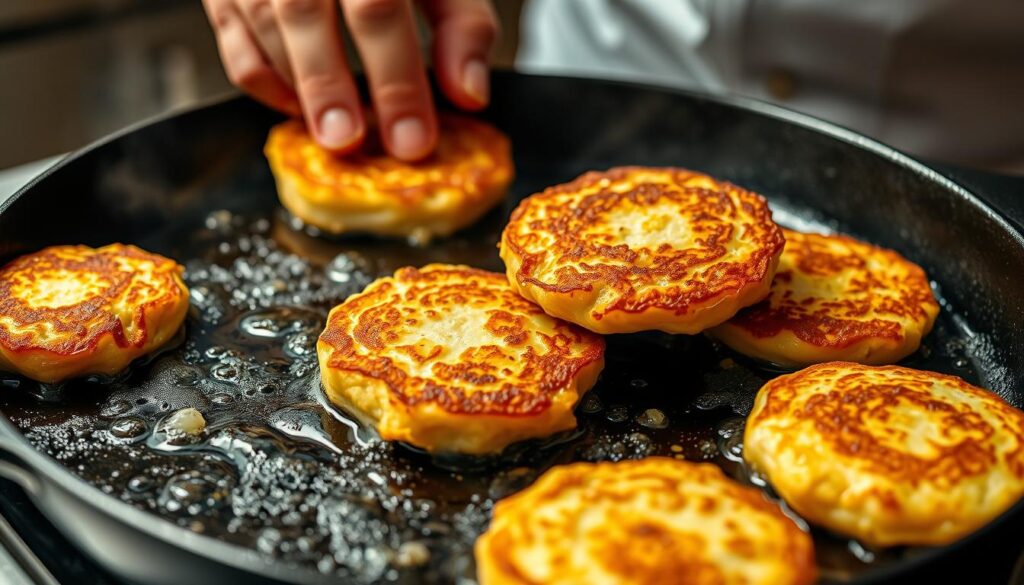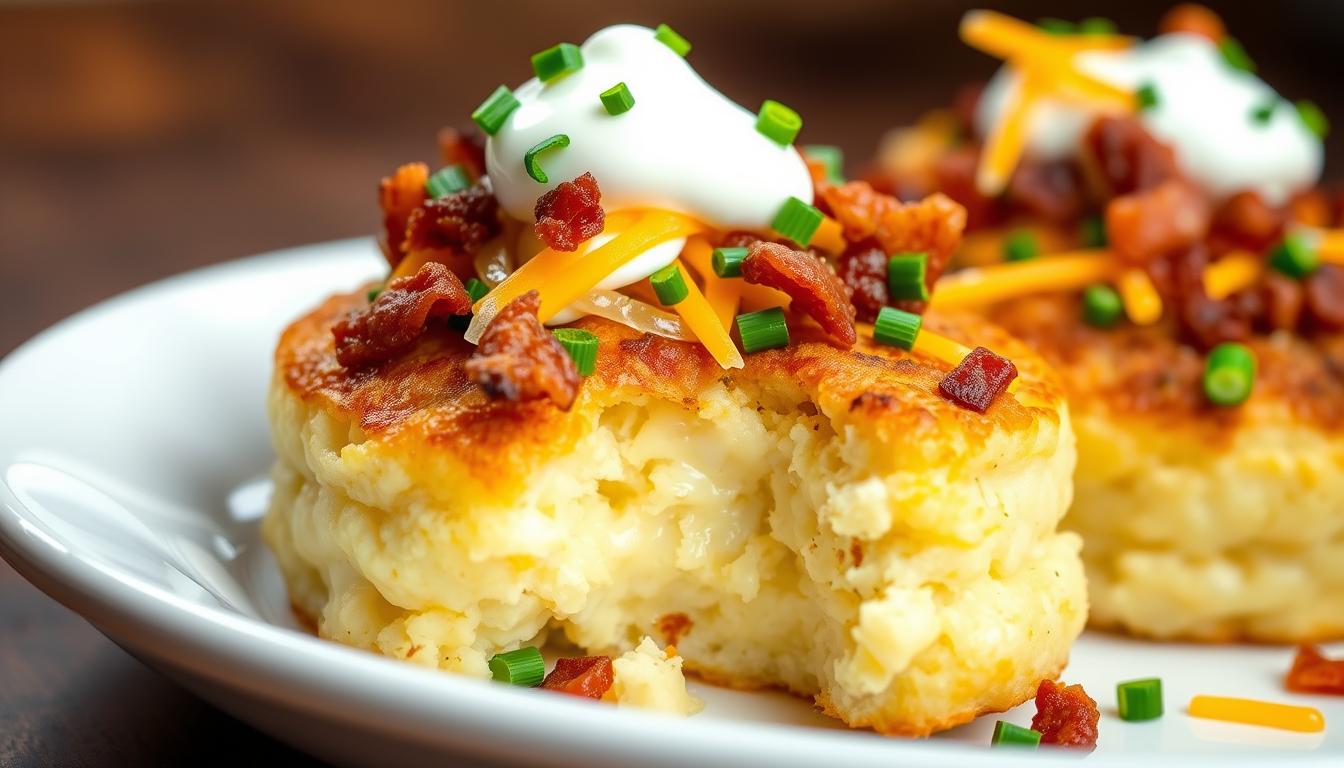Table of Contents
Growing up in a Midwestern kitchen, I learned that comfort food is more than taste. It’s about memories. My grandmother’s crispy loaded mashed potato cakes were a special treat. They turned leftover mashed potatoes into something magical, bringing our family together.
Looking for an easy recipe that’s a crowd-pleaser? Loaded mashed potato cakes are your go-to comfort food. These golden, crispy treats are packed with flavor. They can make any meal unforgettable.
Whether you’re a home cook or looking to reinvent leftover potatoes, this guide is for you. It will show you how to make the most delicious loaded mashed potato cakes you’ve ever had.
Key Takeaways
- Learn how to create perfectly crispy Loaded mashed potato cakes
- Discover versatile ingredient combinations
- Master techniques for achieving golden exteriors
- Transform leftover mashed potatoes into gourmet meals
- Explore easy recipe variations for all skill levels
Why Loaded Mashed Potato Cakes Are the Perfect Comfort Food
Comfort food is a big deal in American cooking. Loaded mashed potato cakes are a perfect example. They are crispy, golden, and bring warmth and nostalgia to your table. They mix familiar flavors with satisfying textures.
Potato dishes are a big part of home cooking. They create memories that connect families through food. Potato cakes are a favorite in many homes because of their versatility.
The History of Potato Cakes in American Cuisine
Loaded mashed potato cakes have a long history in America. Early European immigrants brought their recipes here. They turned simple ingredients into hearty dishes that became American classics.
- Irish settlers introduced potato-based recipes in the 19th century
- Midwestern farmers popularized potato cake variations
- Rural communities developed unique regional recipes
Nutritional Benefits of Potato-Based Dishes
Potato dishes are not just tasty; they’re also good for you. Potatoes are full of nutrients that help keep your diet balanced.
| Nutrient | Amount per Serving | Health Benefit |
|---|---|---|
| Vitamin C | 20% Daily Value | Immune system support |
| Potassium | 15% Daily Value | Heart health |
| Fiber | 10% Daily Value | Digestive wellness |
Learning about Loaded mashed potato cakes history and health benefits shows they’re more than a tasty side. They’re a tradition that keeps evolving and pleasing food lovers everywhere.
Essential Ingredients for Perfect Potato Cakes
Making the best loaded mashed potato cakes begins with the right ingredients. The taste, texture, and success of these dishes depend on what you choose. At the heart of every great potato cake is perfectly mashed potatoes.
Here’s what you need for tasty potato cakes:
- Mashed Potatoes: Use starchy potatoes like Russet or Yukon Gold for the best texture
- Cheese: Sharp cheddar or gouda adds incredible depth of flavor
- Crispy bacon for a savory crunch
- Eggs (for binding)
- All-purpose flour
- Seasonings like salt, pepper, and garlic powder
The secret to potato cakes is finding the right mix of ingredients. Cheese adds richness, and bacon brings a smoky flavor that makes the dish pop.
| Ingredient | Quantity | Purpose |
|---|---|---|
| Mashed Potatoes | 2 cups | Base of the cake |
| Shredded Cheese | 1/2 cup | Flavor and binding |
| Crispy Bacon | 1/4 cup, crumbled | Texture and taste |
| Eggs | 1-2 | Structural integrity |
Pro tip: Use cold mashed potatoes for better cake formation. The chilled potatoes help your cakes hold their shape during cooking.
Kitchen Tools and Equipment You’ll Need
Making tasty loaded mashed potato cakes needs the right tools. The right equipment makes cooking these crispy treats easier. From precise measuring tools to the best frying pans, each item is key to your success.
- Large mixing bowl
- Measuring cups and spoons
- Whisk or fork for mixing
- Spatula for shaping
- Sharp knife
- Cutting board
Selecting the Right Cooking Equipment
The frying pan you choose is vital for your Loaded mashed potato cakes’ texture. Cast iron skillets and non-stick pans are great for a crispy exterior. They heat evenly, giving you a golden-brown crust that will wow everyone.
Storage and Reheating Solutions
Good storage containers keep your Loaded mashed potato cakes fresh and tasty. Choose airtight containers to keep them crisp. Glass or BPA-free plastic containers with tight lids are best for the fridge and storage.
Recommended Reheating Tools
- Oven-safe baking sheet
- Air fryer
- Toaster oven
Pro tip: Avoid microwave reheating, as it can make your potato cakes soggy and lose their crispy texture.
How to Make the Best Loaded Mashed Potato Cakes
Making the perfect Loaded mashed potato cakes needs care and love. This guide will show you how to make delicious loaded mashed potato cakes. They’re sure to wow your family and friends.
First, gather all you need for a great Loaded mashed potato cakes. You’ll need:
- Leftover mashed potatoes (cold works best)
- Shredded cheese
- Crispy bacon bits
- Chopped green onions
- All-purpose flour
- Eggs
- Salt and pepper
Now, follow these steps for cooking:
- Mix cold mashed potatoes with cheese, bacon, and green onions in a large bowl
- Add beaten eggs and flour to bind the mixture
- Season with salt and pepper to taste
- Form the mixture into compact patties, about 3 inches wide
- Coat each patty lightly in additional flour
To cook your Loaded mashed potato cakes, heat oil in a skillet over medium-high heat. Place the patties in the pan. Cook for 3-4 minutes on each side until they’re golden brown and crispy. Keep the heat steady for a crunchy exterior.
Pro tip: Let the potato cakes rest on a paper towel after cooking. This helps soak up excess oil and keeps them crispy. Serve them right away for the best taste.
Tips for Achieving the Perfect Crispy Exterior
Making crispy potato cakes is more than just mixing ingredients. It’s about mastering cooking temperature and choosing the right frying oil. Professional chefs say getting that golden-brown exterior is an art that needs practice and precision.

Mastering crispy potato cakes involves several key techniques. These can take your cooking to the next level. With the right preparation and cooking methods, you can make potato cakes that taste like they’re from a restaurant.
Temperature Control Techniques
Cooking temperature is key to making perfectly crispy potato cakes. Here are some essential tips:
- Preheat your pan to medium-high heat (around 350-375°F)
- Use a cast-iron skillet for even heat distribution
- Test oil temperature with a small potato cake piece before full cooking
- Maintain consistent heat throughout the cooking process
Oil Selection Guide
Choosing the right frying oil is important for your crispy potato cakes’ flavor and texture. Here are some options:
- Vegetable Oil: Neutral flavor, high smoke point
- Canola Oil: Light taste, good for high-temperature cooking
- Peanut Oil: Adds subtle nutty flavor, excellent for crispy results
Pro tip: Don’t overcrowd the pan, as it can lower the oil temperature and make the potato cakes soggy. Cook in batches to ensure each cake is crispy and golden brown.
Delicious Topping Combinations and Variations
Take your potato cake game to the next level with creative toppings. These toppings can turn a simple dish into a masterpiece. It’s all about finding the right mix that matches your taste and the occasion.
Here are some ways to make your potato cakes stand out:
- Classic Breakfast Style: Top with crispy bacon bits, shredded cheddar cheese, and a dollop of sour cream
- Mediterranean Twist: Garnish with crumbled feta, chopped olives, and fresh herbs
- Spicy Southwest: Add jalapeños, pepper jack cheese, and a drizzle of chipotle sauce
- Vegetarian Delight: Sprinkle with roasted vegetables and goat cheese
Think about using toppings that range from savory to fancy. Here are some ideas from professional chefs to make your dish shine:
| Flavor Profile | Recommended Toppings |
|---|---|
| Gourmet | Truffle oil, parmesan shavings, microgreens |
| Rustic | Caramelized onions, crispy pancetta, fresh thyme |
| Comfort | Gravy, melted cheese, green onions |
With these ideas, you’ll never run out of ways to make potato cakes exciting. Try different toppings to find your favorite loaded mashed potato cake recipe.
Common Mistakes to Avoid When Making Potato Cakes
Making the perfect potato cake can be tricky. Even experienced cooks face challenges. Knowing common mistakes and how to fix them will help you get crispy, flavorful results every time.
Potato cake preparation needs attention to detail. The right techniques can turn your dish into something amazing.
Texture Troubleshooting Strategies
Texture is key when making potato cakes. Avoiding common issues will help your cakes be crispy outside and creamy inside.
- Avoid using watery potatoes that can make your cakes soggy
- Drain mashed potatoes thoroughly before mixing
- Use cold or room temperature potatoes for better binding
- Add breadcrumbs to improve structural integrity
Storage and Reheating Tips
Proper storage and reheating are key to keeping your potato cakes fresh. Follow these tips to keep their delicious texture.
| Storage Method | Duration | Recommended Technique |
|---|---|---|
| Refrigerator | 3-4 days | Store in airtight container |
| Freezer | Up to 1 month | Wrap individually in plastic wrap |
| Reheating | 10-15 minutes | Oven at 375°F for crispy texture |
By understanding these mistakes and using the right troubleshooting techniques, you’ll become a pro at making perfect potato cakes every time.
Serving Suggestions and Pairing Ideas
Potato cake serving ideas can make your meals special. They are great for any occasion, from family dinners to fancy parties.
When it comes to food pairings, your loaded mashed potato cakes are a hit. Here are some tasty serving ideas:
- Breakfast pairings:
- Serve with crispy bacon or scrambled eggs
- Top with a poached egg for added richness
- Lunch and dinner options:
- Accompany grilled chicken or roasted vegetables
- Create a hearty main course with a side salad
- Party and appetizer settings:
- Cut into smaller bite-sized portions
- Serve with dipping sauces like garlic aioli or ranch
For easy meal planning, make potato cakes ahead of time. They stay delicious and keep their texture well.
Pro tip: Try new toppings and garnishes to keep your potato cakes interesting for every meal.
Make-Ahead and Storage Instructions
Making potato cakes ahead of time is a great way to save time. It lets you enjoy tasty meals with less effort. You can keep your loaded mashed potato cakes fresh for a long time.
Here’s how to freeze your potato cakes to keep them perfect:
- Cool potato cakes completely before storing
- Place individual cakes on a parchment-lined baking sheet
- Freeze for 1-2 hours until solid
- Transfer frozen cakes to airtight containers or freezer bags
Refrigeration is also a good way to store your potato cakes. You can keep them in the fridge for 3-4 days. Just reheat them in a skillet to get that crispy outside again.
Freezing is the best for long-term storage. Frozen potato cakes can last 2-3 months. To thaw, leave them in the fridge overnight. Then, reheat in a preheated oven at 375°F for the best crispiness.
- Pro tip: Separate layers with parchment paper to prevent sticking
- Always label containers with the date of preparation
- Avoid refreezing previously frozen potato cakes
Learning these storage tips means you’ll always have tasty potato cakes ready. Enjoy them whenever you want!
Conclusion
Loaded mashed potato cakes are more than just a comfort food. They let you show off your creativity in the kitchen. With just a few ingredients and simple steps, you can make tasty homemade snacks from leftover mashed potatoes.
Exploring these potato cakes opens up a world of flavors. You can stick to classic toppings or try new global seasonings. This recipe is all about being flexible and making ordinary ingredients into something special.
Getting good at making these potato cakes takes time. Each batch you make will help you get better at texture, seasoning, and cooking. Enjoy the learning, share your dishes, and relish the delicious outcomes of your cooking adventures.
We encourage you to make these loaded mashed potato cakes your own. Try new things, taste, and create memories. This simple yet amazing comfort food adds warmth and joy to any meal.

